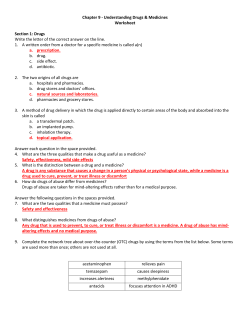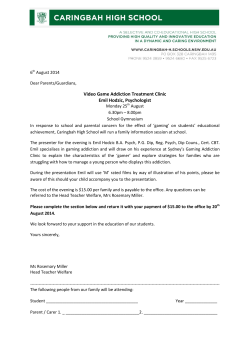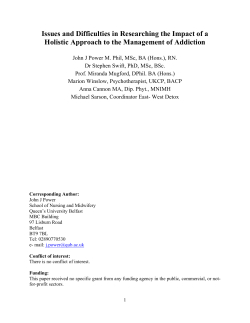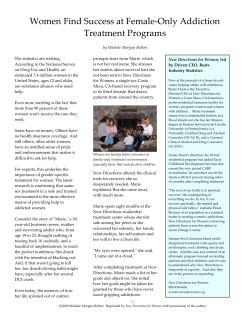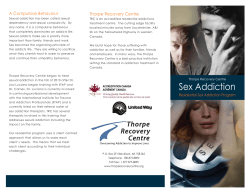
Document 111957
Newsletter of the SupportNet Client Education Program - October 2013 Celebrity addictions are a day to day part of the news. Whether it be Charlie Sheen or Lindsay Lohan - a celebrity struggling with addiction is one you will hear about. Too bad there isn’t more talk about celebrities who have beaten their addictions. Here are a few who have George Carlin checked into rehab Christmas 2004 - to deal with his addiction to alcohol and prescription pills. He admits it really was a ‘sobering’ experience. ‘I definitely suffered the affliction that every addict suffers - I just couldn't stop. The addiction had more power than I did.’ A rehab stay and relapse prevention program helped Carlin get his addiction under control. ‘I don’t have a yen to go back there again. If I pass the wine section at the supermarket - I just say - Remember where that took you George! And I never tell my doctor about my aches , pains or anxieties.’ Slash is one of the most recognizable figures in rock music - and he was also one of the most prolific drug users - including heroin and alcohol. But In 2001 the former Guns n' Roses guitarist was diagnosed with congestive heart failure as a result of drug use - and he decided to seek help. In his recovery - Slash performs the song ‘You're a Lie’ - about his relationship with drugs - I trusted you and there was no one else. All you did was make me doubt myself. Don’t believe you anymore. You bled me out, you tore me down - Your time has come, you can go.‘Cause you’re a lie, lie, lie. Eric Clapton once spent $16,000 a week on heroin - giving away three years of his life to the dangerous drug. At one performance during his addiction - he passed out and had to be revived on stage. Pulling himself away from heroin - he became an alcoholic. It took guitarist Pete Townsend - another former addict - to convince him that there was a better way to live. Clapton has used his experience to establish the Crossroads Centre for drug and alcohol treatment in Antigua. Proceeds from The Crossroads Guitar Festival are used to support the treatment centre. Celebrity Addiction Recovery Con’t . . . Robert Downey Jr. first smoked marijuana at the age of six. He grew up in a household where drugs were easily accessible and developed a habit for cocaine and heroin, among others. A very talented actor with a promising career, Downey was arrested several times - and his addictions became the punch line for late night jokes. His addiction cost him his role in the television series ‘Ally McBeal’ and at least one starring role in a major movie. After the low point in his life resulting from his drug abuse - he entered rehab and quit his drug habit for good. Today - he is one of America's biggest movie stars - regularly starring in blockbuster shows. Jaime Lee Curtis - Her two biggest accomplishments? According to her, motherhood . . . and beating an addiction to painkillers. Opiate Addiction: How prescription painkillers pave the way to heroin The use of prescription painkillers is at epidemic level - according to the US Center for Disease Control and Prevention (2012). What is it about the pills that makes them so dangerously addictive - and a potential gateway to the use of heroin? The surprising answer is that the common painkillers that doctors and dentists now prescribe to patients after injuries and surgeries have the same active ingredients as the street drug heroin. And both act in similar ways on the human brain - to produce a sense of pleasure - that can overwhelm the brain’s reasoning functions. While many who abuse prescription painkillers think of heroin as a low-class drug that will never make its way into their lives - they don't realize that they're already addicted to prescription drugs more similar than different to heroin. Prescription painkillers of the sort that twelve million Americans used non-medically in 2010, according to the CDC, are narcotic drugs, more commonly referred to as opiates. They include hydrocodone and oxycodone - also known by the brand names Dilaudid, Oxycontin, Fentanyl and others. According to the National Institute on Drug Abuse - when opiates are consumed - they enter the bloodstream and activate neurotransmitter receptors in the brain's reward system. Although the initial effect of the drug is rewarding - and results in a "high" or feeling of euphoria - the effect is time limited. After the high wears off - the user feels much worse than before having taken the drug. Addiction psychiatrist Dr. Stuart Gitlow says "The only connection a patient makes is that use of the drug leads to immediate relief - not the longer-lasting discomfort that follows. Unfortunately, the drug causes both the immediate relief and the following discomfort. As time passes, the discomfort becomes more apparent than the relief - and the drug is used merely in an effort to avoid the discomfort that the drug has caused in the first place.” . . . Addiction and Recovery Issues - In The News None of the these comments will be news to clients of 528 Dundas Street - who’ve survived their own experience with prescription painkiller drugs - and who have read our very own ‘What Do Pirates, Tea, Hong Kong, Heroin and Oxys Share In Common?’ And it is a good thing that we have our own literature here in Canada - because - Canada is second highest in world for prescribed opiate drug use No country wants to be known as the leader in the prescription of opiate drugs. But Canada is pretty close - we’re number two on a world list in terms of per capita opiate use - just behind our American friends to the south. Just a few years ago, we were number six - but “We don’t want to get to number one” says Michel Perron - chief executive officer of the Canadian Centre on Substance Abuse. Evidence of a prescription drug crisis is “beyond compelling - it is blinding’’ - Perron told the Star - speaking after a presentation to the Toronto Board of Health. “We simply cannot continue to prescribe prescription drugs at the current level” says Perron. But while Canadians should have appropriate access to prescription drugs, “many would argue we’re over-medicated with stimulants, sedatives and painkillers . . . At the end of the day the prescribing of opiates in recent years has gone through a very significant increase” - he says. Part of the new strategy will be to “off-load some of the reliance from pharmacological support or remedies, to non-pharmacological . . . yoga, massage or other options” - he says. “There are many ways by which we can attenuate harm or pain.” The CCSA strategy will define the “scope of the crisis Canada faces and provide a ten year road map to reduce the harms associated with prescription drugs.” It also refers to certain prescription drugs like opioids, stimulants, sedatives and tranquilizers being associated with “devastating harms such as addiction, overdose and death” - and having a terrible impact on families, the health-care system, social services and public safety. Perron said the report being released “brings together the finest minds in Canada” referring to participatory work from members of the medical, public health and pain management communities as well as researchers, treatment providers, addiction specialists and others. “We want to focus on what needs to be done first - and then on collaboration with the pharmaceutical industry.” (Talk about closing the barn door - after the horse has run away. ed.) Smoking Cessation Crossword Puzzle . . .
© Copyright 2025


